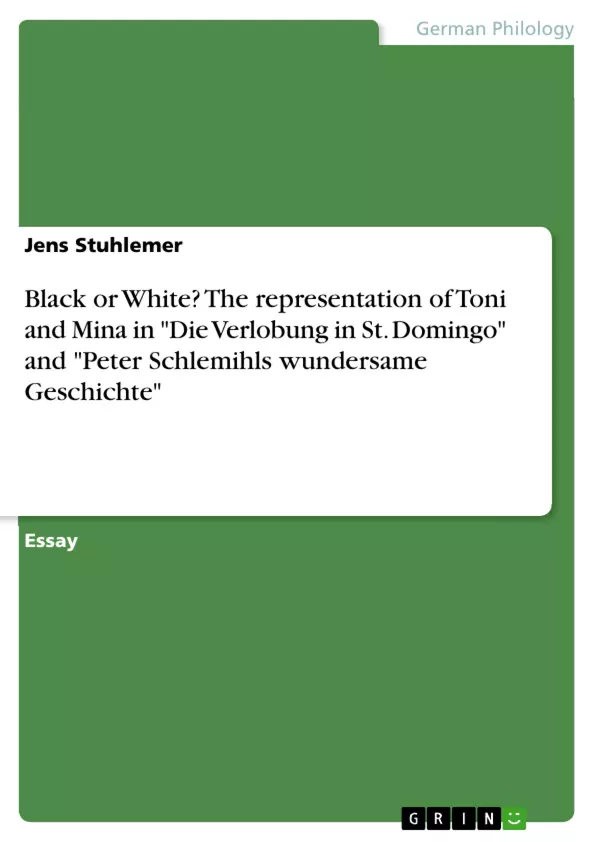This essay will discuss similarities as well as crucial differences between the female characters Mina and Toni. Even though Mina's part in Chamissio's narrative is relatively small, it will be argued that she represents a specific representation of female charachters in romantic texts. Toni, on the hand, not only takes a central role in Kleist's narrative, but is also defined in a very contradicting way to Mina. Nonetheless, both characters still share a lot of features. Possible explanations for this diversity will be given by a close reading of both texts, a focus on historical circumstances and by taking into account the mere characteristics of romanticism and ancient archetypes. Furthermore, slight interpretations of other main characters of both narratives need to be given to present a wider understanding of Mina and Toni, as well as comparisons to other female characters of the romantic era.
Inhaltsverzeichnis (Table of Contents)
- Black or White: The Representation of Toni and Mina in Die Verlobung in St. Domingo and Peter Schlemihls wundersame Geschichte
- Mina and Toni: Similarities and Differences
- Mina's Role in Peter Schlemihls wundersame Geschichte
- Toni's Central Role in Die Verlobung in St. Domingo
- A Closer Look at the Characters
- Mina's Idealized Image
- Toni's Connection to Gustav
- Toni's Development and the French Revolution
- Interpreting the Texts: Classic and Romantic Elements
- Kastinger's Perspective on Romantic Literature
- Symbolism in Art and Literature
- The Role of Individuality in Romantic Texts
Zielsetzung und Themenschwerpunkte (Objectives and Key Themes)
This essay examines the representation of the female characters Mina and Toni in two romantic texts, "Peter Schlemihls wundersame Geschichte" and "Die Verlobung in St. Domingo." The essay explores the similarities and differences between the characters, analyzing their portrayal within the broader context of romanticism and historical circumstances. It aims to uncover the specific representations of female characters in romantic texts, particularly in relation to ancient archetypes and the changing societal landscape.
- The representation of female characters in romantic texts
- The interplay of ancient and modern values in the characters' portrayal
- The influence of historical context, particularly the French Revolution, on the characters' development
- The role of individual agency and self-definition in romantic texts
- The relationship between male protagonists and their idealized female counterparts
Zusammenfassung der Kapitel (Chapter Summaries)
- The essay begins by introducing the two central female characters, Mina and Toni, and highlighting their contrasting roles and portrayals in the respective narratives. It emphasizes Mina's idealized and passive nature in "Peter Schlemihls wundersame Geschichte" and Toni's more complex and active role in "Die Verlobung in St. Domingo."
- The essay then delves into a detailed analysis of each character's portrayal, drawing parallels to other romantic texts and examining their relationship to ancient archetypes. It explores the symbolism surrounding Mina, including her association with purity, innocence, and the ideal feminine image, and analyzes Toni's connection to Gustav, the male protagonist, and her multifaceted development.
- The essay further explores the interplay between classical and romantic elements in both texts, referencing Kastinger's perspective on romantic literature and highlighting the influence of the French Revolution. It analyzes how the characters' actions and motivations reflect the shifting societal norms and the growing emphasis on individuality.
- Finally, the essay examines the symbolism present in both texts, drawing connections to art and literature. It analyzes the contrasting interpretations of "Mars and Venus" and "Venus and Adonis" in relation to the narratives of "Peter Schlemihls wundersame Geschichte" and "Die Verlobung in St. Domingo," highlighting the role of male desire and its impact on the female characters.
Schlüsselwörter (Keywords)
This essay focuses on the representation of female characters in romantic texts, particularly the contrasting portrayals of Mina and Toni in "Peter Schlemihls wundersame Geschichte" and "Die Verlobung in St. Domingo." Key concepts include romanticism, ancient archetypes, the French Revolution, individual agency, self-definition, male desire, and the interplay between classical and modern values.
- Quote paper
- Jens Stuhlemer (Author), 2002, Black or White? The representation of Toni and Mina in "Die Verlobung in St. Domingo" and "Peter Schlemihls wundersame Geschichte", Munich, GRIN Verlag, https://www.grin.com/document/379266



